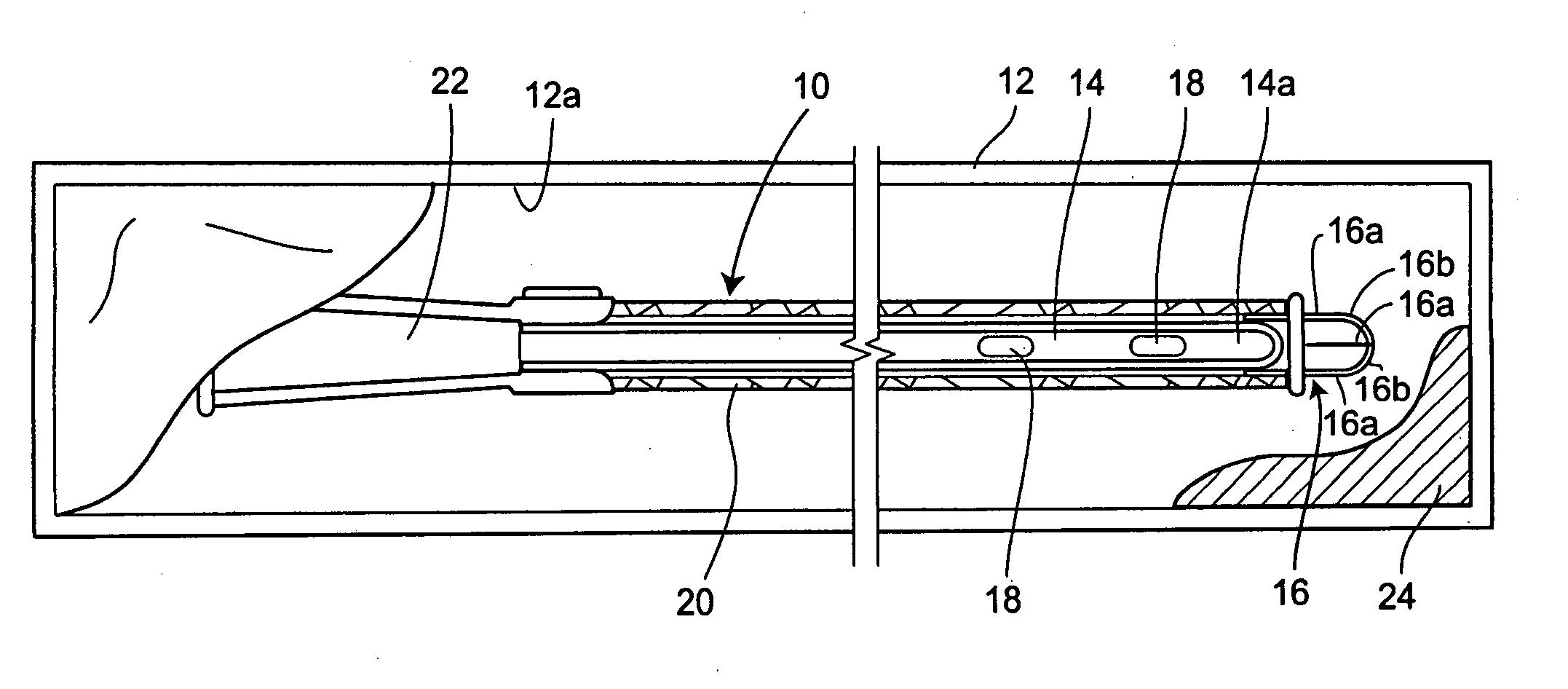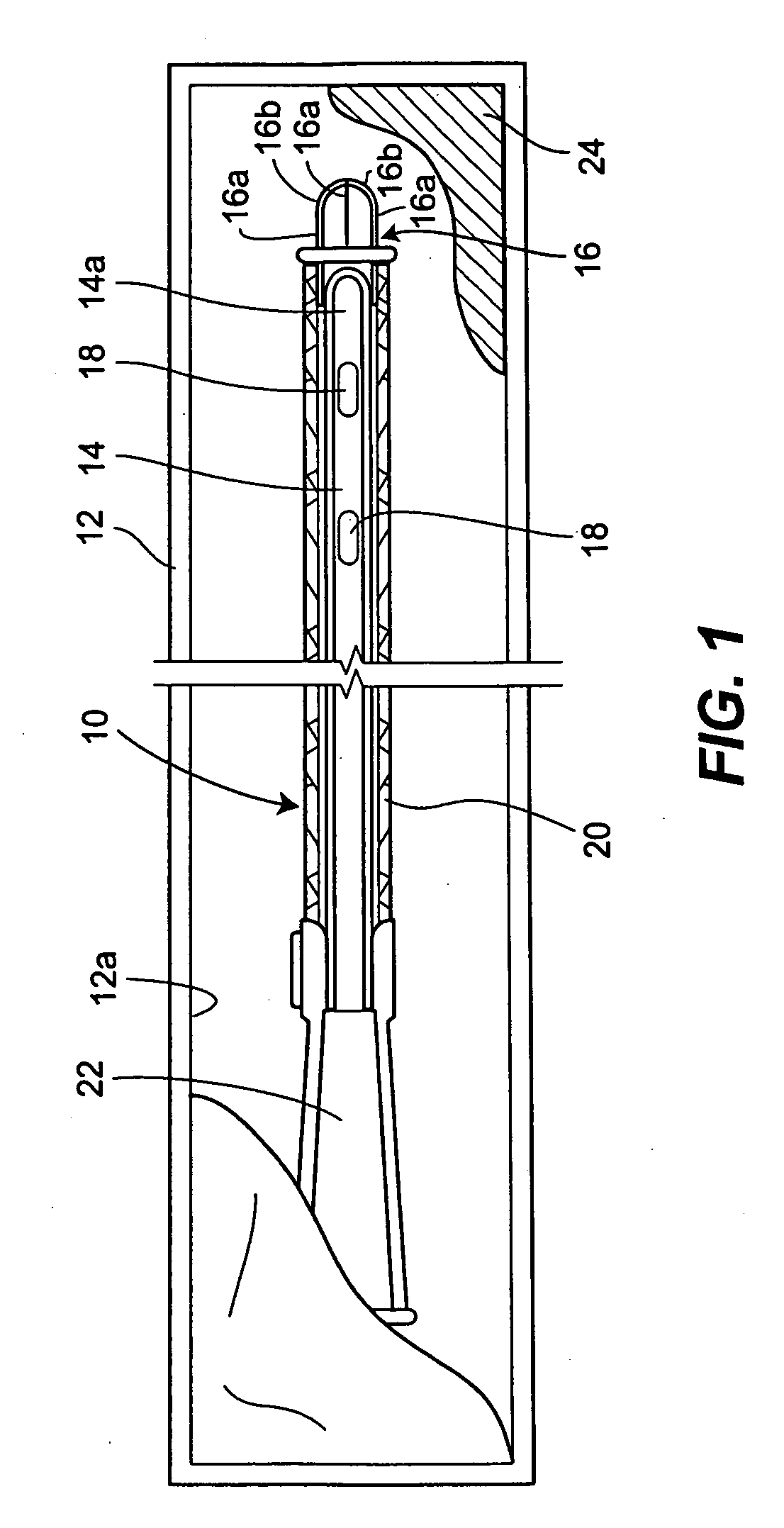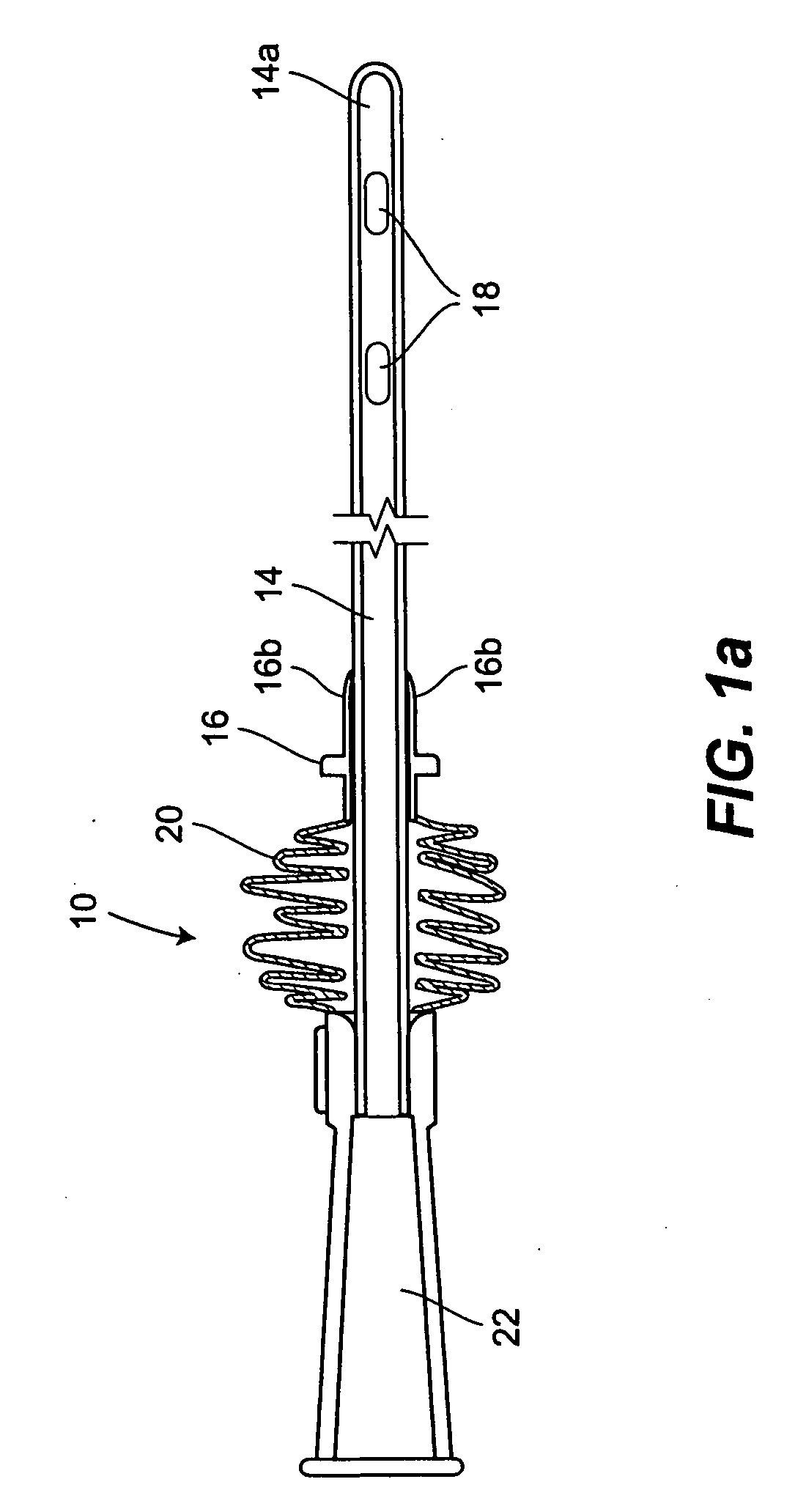Vapor hydration of a hydrophilic catheter in a package
a hydrophilic catheter and vapor hydration technology, which is applied in the direction of catheters, containers for flexible objects, containers preventing decay, etc., can solve the problems of immersion liquid spillage, difficult for users to handle during insertion, and easy to spill immersion liquid from the package, so as to reduce the amount of material used, the effect of less or no liquid spillage and easy handling for users
Active Publication Date: 2006-07-27
HOLLISTER INCORPORAED
View PDF8 Cites 103 Cited by
- Summary
- Abstract
- Description
- Claims
- Application Information
AI Technical Summary
Benefits of technology
[0014] The hydrophilic catheter of the present invention is vapor hydrated with a vapor swelling medium such as water vapor within the catheter package in such a manner that it is ready for use when it reaches the user with little or no possibility of liquid spillage. It results in a sterile catheter package that does not require the addition of an immersion liquid but, rather, already has the hydrophilic surface coating of the catheter activated by reason of vapor hydration. The catheter package may contain a liquid sequestering element such as fabric or foam sized to contain an amount of liquid that can produce sufficient vapor to form and maintain a vapor hydration atmosphere within the package cavity. The fabric or foam liquid sequestering element reliably holds liquid in its interstices to prevent loose liquid from presenting a spill hazard while permitting vapor to be formed and escape into the package cavity. The catheter pac
Problems solved by technology
Moreover, all of these existing products achieve this direct liquid water contact by providing a package for the catheter that permits liquid water to flow freely within the cavity of the package, and permits unobstructed access to the catheter surface.
A disadvantage of the hydrophilic coated catheters described above is that the immersion liquid has a tendency to spill from the package as the user handles the catheter and tries to remove it for subsequent insertion.
Another disadvantage of the hydrophilic coated catheters described above is that the catheter has an extremely slippery surface which makes it quite difficult for the user to handle during insertion.
For catheters that are removed from the package and then inserted, there is another disadvantage in that the handling of the catheter by the user will introduce microorganisms onto the surface of the catheter which can cause infectious problems after being introduced into the body during catheter insertion.
For hydrophilic coated catheters, there has also bee
Method used
the structure of the environmentally friendly knitted fabric provided by the present invention; figure 2 Flow chart of the yarn wrapping machine for environmentally friendly knitted fabrics and storage devices; image 3 Is the parameter map of the yarn covering machine
View moreImage
Smart Image Click on the blue labels to locate them in the text.
Smart ImageViewing Examples
Examples
Experimental program
Comparison scheme
Effect test
 Login to View More
Login to View More PUM
| Property | Measurement | Unit |
|---|---|---|
| Fraction | aaaaa | aaaaa |
| Fraction | aaaaa | aaaaa |
| Time | aaaaa | aaaaa |
Login to View More
Abstract
A vapor hydrated packaged catheter assembly and method of manufacturing and distributing same includes a gas impermeable package housing a catheter within a catheter-receiving cavity. The catheter assembly has a hydrophilic coating applied to at least a portion of the outer surface of a catheter tube or shaft which may be surrounded by a sleeve to provide a no-touch, sure grip feature. The catheter assembly is disposed within the catheter receiving cavity of the package together with a limited amount of a vapor donating liquid provided as a source of vapor to activate the hydrophilic coating. The amount of vapor donating liquid is less than the amount that would otherwise be sufficient to cause a spill hazard. It may be loose liquid as a desired percentage of the volume of a tube-receiving portion of the catheter receiving cavity of the package, or it may be contained in a liquid sequestering element. The activation of at least some of the hydrophilic coating occurs solely by reason of exposure of the outer surface of the catheter to a vapor produced by the vapor donating liquid. The distribution of the catheter following manufacture is delayed for a time sufficient to permit the vapor to complete hydration of the entire hydrophilic coating on the surface.
Description
REFERENCE TO RELATED APPLICATIONS [0001] This disclosure claims priority to, and is entitled to the benefit of, U.S. Provisional Application No. 60 / 493,493, filed on Aug. 8, 2003, for all subject matter commonly disclosed therein.BACKGROUND [0002] Intermittent catheterization is a good option for many users who suffer from various abnormalities of the urinary system. A common situation is where single use, individually packaged, sterile catheters are used. An important criterion for any single use product is the cost of the product, i.e., a less expensive product is desired and valued. [0003] It is also quite common for catheters to be provided with a surface treatment using a lubricant to reduce friction in order to allow for easier and less traumatic insertion. Currently, there are two major categories of catheters having lubricated surfaces, i.e., gel coated catheters and hydrophilic coated catheters. [0004] The gel coated catheters are made easier to insert by application to the...
Claims
the structure of the environmentally friendly knitted fabric provided by the present invention; figure 2 Flow chart of the yarn wrapping machine for environmentally friendly knitted fabrics and storage devices; image 3 Is the parameter map of the yarn covering machine
Login to View More Application Information
Patent Timeline
 Login to View More
Login to View More IPC IPC(8): B65D83/10A61LA61M25/00A61M25/01B65D85/08
CPCA61M25/0009A61M25/0017A61M25/002B65B55/22A61M25/0111A61M2025/0046A61M2025/0681A61M25/007B65B5/04B65B7/02B65D81/22
Inventor MURRAY, MICHAELGILMAN, THOMAS H.SWEENEY, SEANCREAVEN, MARTIN P.
Owner HOLLISTER INCORPORAED
Features
- R&D
- Intellectual Property
- Life Sciences
- Materials
- Tech Scout
Why Patsnap Eureka
- Unparalleled Data Quality
- Higher Quality Content
- 60% Fewer Hallucinations
Social media
Patsnap Eureka Blog
Learn More Browse by: Latest US Patents, China's latest patents, Technical Efficacy Thesaurus, Application Domain, Technology Topic, Popular Technical Reports.
© 2025 PatSnap. All rights reserved.Legal|Privacy policy|Modern Slavery Act Transparency Statement|Sitemap|About US| Contact US: help@patsnap.com



